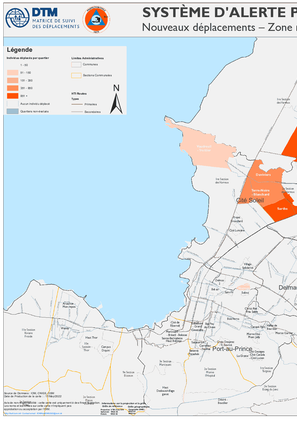-
Countries
-
Data and Analysis
-
Special Focus
-
Crisis Responses
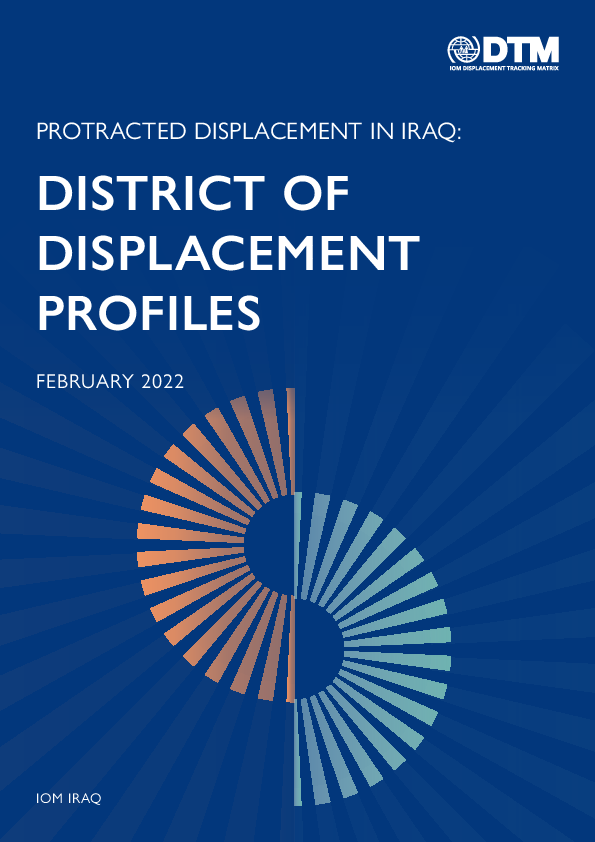
Contact
DTM Iraq, iraqdtm@iom.int
Language
English
Location
Iraq
Period Covered
Jan 01 2021
Sep 30 2021
Activity
- Other
In April 2019, the International Organization for Migration’s (IOM) Displacement Tracking Matrix (DTM) unit in Iraq published a report, “An In-Depth Analysis of the Main Districts of Displacement.” The aim of this report was to complement the information presented in a separate in-depth analysis of return barriers faced by IDPs presented in the report, “Reasons to Remain: Categorizing Protracted Displacement in Iraq,” which was published in November 2018.
In January 2021, IOM Iraq then produced an updated in-depth report on return barriers, “Protracted Displacement in Iraq: Revisiting Categories of Return Barriers.” This report drew on data that had been collected since November 2018 in locations of displacement and return, and is centred on a categorization framework that highlights the different reasons why the remaining 1.2 million IDPs remained displaced at that time. The report examined the extent that IDPs across the country face different types barriers to returning to their area of origin. However, the report featured data aggregated to the levels of overall (national) as well as governorates and, on some occasions, districts. However, given that the remaining IDPs reside in 105 districts spread across 8 governorates, district level information that was presented in the report was limited, including how conditions vary between subdistricts within a particular district.
As of 30 September 2021, a total of 204,344 IDP households (1,189,581 individuals) remain displaced across the country – amounting to 20 per cent of all those who became displaced during the period of ISIL conflict (2014-2017). These IDPs reside in a total of 2,842 locations across 105 districts and 8 governorates across the country. Amongst the remaining IDPs, 79 per cent reside in the top 15 of these districts. This document is comprised of 15 four-page profiles of each of these districts.

Contact
DTM Iraq, iraqdtm@iom.int
Language
English
Location
Iraq
Period Covered
Aug 01 2020
Apr 30 2021
Activity
- Other
In April 2019, the International Organization for Migration’s (IOM) Displacement Tracking Matrix (DTM) Unit in Iraq published a report, “An In-Depth Analysis of the Main Districts of Origin.” The aim of this report was to complement the information in a separate in-depth analysis of return barriers faced by IDPs, presented in the report “Reasons to Remain: Categorizing Protracted Displacement in Iraq,” which was published in November 2018.
In January 2021, IOM produced an updated in-depth report on return barriers, “Protracted Displacement in Iraq: Revisiting Categories of Return Barriers.” This report drew on data that had been collected since November 2018 in locations of displacement and return, and is centered on a categorization framework highlighting the different reasons why the remaining 1.2 million IDPs remained in displacement at that time. This report highlighted the key return barriers faced by IDPs in the eight governorates of displacement, and identified key challenges faced by returnees that would likely represent return barriers in the 8 governorates of return/origin. However, the data included in this report was reported on based on the locations where IDPs are displaced. As such, a gap in updated information has remained related to how conditions of IDPs vary according to the districts from which they originate – including factors affecting their prospects of returning home – as well as the conditions faced by returnees who have arrived back to these districts.
As at 30 April 2021, a total of 1,198,940 IDP individuals remain displaced across 18 governorates and 105 districts. However, 95 per cent of this group originate from just 25 districts within 8 governorates. To address a gap of up-to-date information at district level and provide an update of the report published in April 2019, DTM developed this report, which is based on an analysis of 17 of the main districts from which IDPs originate across a range of quantitative indicators.
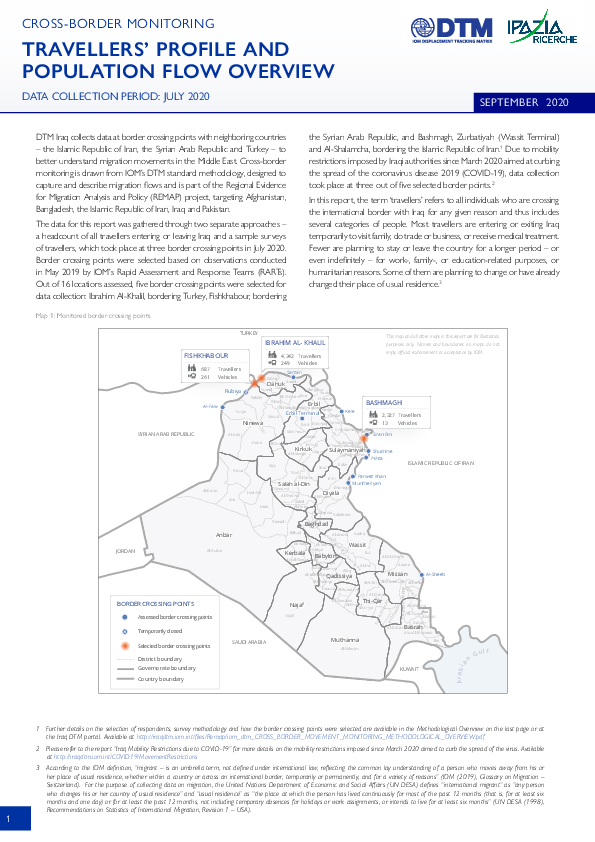
Contact
DTM Iraq, IraqDTM@iom.int
Language
English
Location
Iraq
Period Covered
Jul 01 2020
Jul 31 2020
Activity
- Flow Monitoring Survey
DTM Iraq collects data at border crossing points with neighboring countries – the Islamic Republic of Iran, the Syrian Arab Republic and Turkey – to better understand migration movements in the Middle East.
Cross-border monitoring is drawn from IOM’s DTM standard methodology, designed to capture and describe migration flows and is part of the Regional Evidence for Migration Analysis and Policy (REMAP) project, targeting Afghanistan, Bangladesh, the Islamic Republic of Iran, Iraq and Pakistan.
The data for this report was gathered through two separate approaches – a headcount of all travellers entering or leaving Iraq and a sample surveys

Contact
DTM Iraq, IraqDTM@iom.int
Language
English
Location
Iraq
Period Covered
Jun 01 2020
Jun 30 2020
Activity
- Flow Monitoring Survey
DTM Iraq collects data at border crossing points with neighboring countries – the Islamic Republic of Iran, the Syrian Arab Republic and Turkey – to better understand migration movements in the Middle East.
Cross-border monitoring is drawn from IOM’s DTM standard methodology, designed to capture and describe migration flows and is part of the Regional Evidence for Migration Analysis and Policy (REMAP) project, targeting Afghanistan,
Bangladesh, Iran, Iraq and Pakistan.
The data for this report was gathered through two separate approaches – a headcount of all travellers entering or leaving Iraq and a sample survey of travellers, which took place at three border crossing points during June 2020..
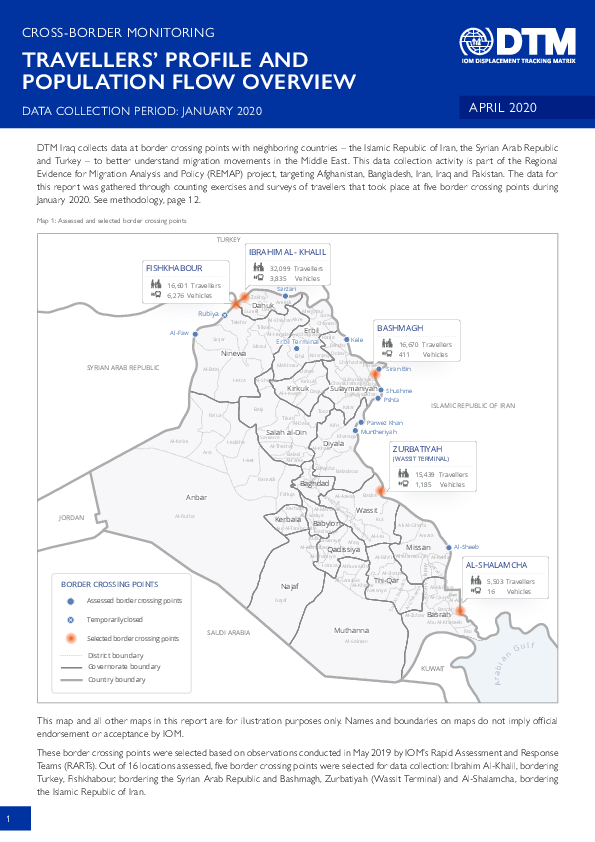
Contact
DTM Iraq, IraqDTM@iom.int
Language
English
Location
Iraq
Period Covered
Jan 01 2020
Jan 31 2020
Activity
- Flow Monitoring Survey
DTM Iraq collects data at border crossing points with neighboring countries – the Islamic Republic of Iran, the Syrian Arab Republic and Turkey – to better understand migration movements in the Middle East. This data collection activity is part of the Regional Evidence for Migration Analysis and Policy (REMAP) project, targeting Afghanistan, Bangladesh, Iran, Iraq and Pakistan.
The data for this report was gathered through counting exercises and surveys of travellers that took place at five border crossing points during January 2020.
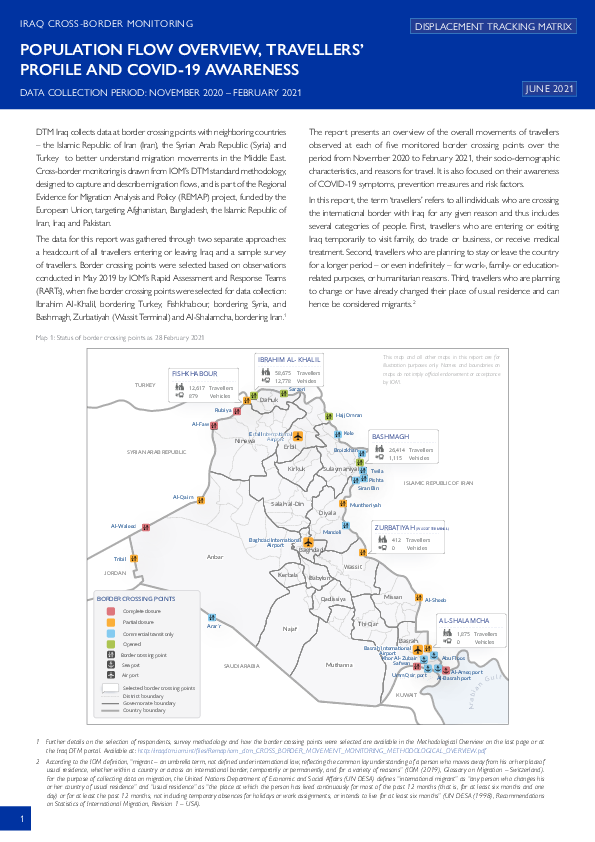
Contact
DTM Iraq, IraqDTM@iom.int
Language
English
Location
Iraq
Period Covered
Nov 01 2020
Feb 28 2021
Activity
- Flow Monitoring Survey
DTM Iraq collects data at border crossing points with neighboring countries – the Islamic Republic of Iran (Iran), the Syrian Arab Republic (Syria) and Turkey to better understand migration movements in the Middle East.
Cross-border monitoring is drawn from IOM’s DTM standard methodology, designed to capture and describe migration flows, and is part of the Regional Evidence for Migration Analysis and Policy (REMAP) project, funded by the European Union, targeting Afghanistan, Bangladesh, the Islamic Republic of Iran, Iraq and Pakistan.
The report presents an overview of the overall movements of travellers observed at each of five monitored border crossing points over the period from November 2020 to February 2021, their socio-demographic characteristics, and reasons for travel. It is also focused on their awareness of COVID-19 symptoms, prevention measures and risk factors.

Contact
DTM Iraq, IraqDTM@iom.int
Language
English
Location
Iraq
Period Covered
Sep 01 2020
Sep 30 2020
Activity
- Flow Monitoring Survey
DTM Iraq collects data at border crossing points with neighboring countries – the Islamic Republic of Iran (Iran), the Syrian Arab Republic (Syria) and Turkey – to better understand migration movements in the Middle East.
Cross-border monitoring is drawn from IOM’s DTM standard methodology, designed to capture and describe migration flows and is part of the Regional Evidence for Migration Analysis and Policy (REMAP) project, targeting Afghanistan, Bangladesh, the Islamic Republic of Iran, Iraq and Pakistan.
The report presents an overview of the overall movements of travellers observed at each of three monitored border crossing points during September 2020, their socio-demographic characteristics, and reasons for travel. It is also focused on their awareness of COVID-19 symptoms, prevention measures and risk factors.

Contact
DTM Iraq, IraqDTM@iom.int
Language
English
Location
Iraq
Period Covered
Aug 01 2020
Aug 31 2020
Activity
- Flow Monitoring Survey
DTM Iraq collects data at border crossing points with neighboring countries – the Islamic Republic of Iran (Iran), the Syrian Arab Republic (Syria) and Turkey – to better understand migration movements in the Middle East.
Cross-border monitoring is drawn from IOM’s DTM standard methodology, designed to capture and describe migration flows and is part of the Regional Evidence for Migration Analysis and Policy (REMAP) project, targeting Afghanistan, Bangladesh, the Islamic Republic of Iran, Iraq and Pakistan.
The report presents an overview of the overall movements of travellers observed at each of three monitored border crossing points during August 2020, their socio-demographic characteristics and reasons for travel. It is also focused on their awareness of COVID-19 symptoms, prevention measures and risk factors.
Système D’alerte Précoce pour les Déplacements - Nouveaux déplacements – Zone métropolitaine de Port-au-Prince – 23 avril au 6 mai 2022
Haiti – Système D’alerte Précoce pour les Déplacements – Nouvelles arrivées de PDI – Zone métropolitaine de Port-au-Prince – 23 avril au 6 mai 2022
